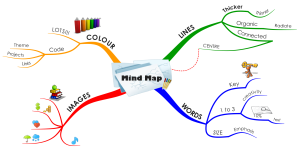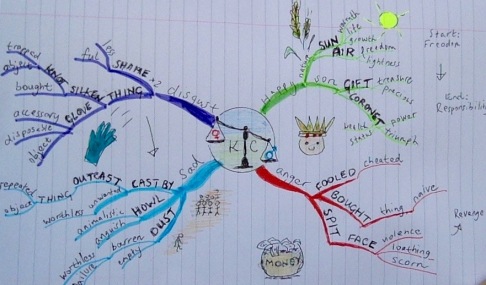Mind-mapping was popularised by Tony Buzan, a psychologist and brain scientist, as a technique that engages both sides of the brain to increase memory retention and productivity, (Buzan, 1976; Buzan, 1993). Naturally, it has its critics, especially since the demise of learning styles and the debunking of the idea that individuals rely on left or right hemisphere. However, there is good evidence that we remember material better when we organise it into semantically meaningful categories (e.g. Bower et al) and that our capacity to remember images compared with words is quite remarkable. (e.g. Ralph Haber’s seminal research)
This post explores how we might use mind-maps for two different purposes within the anthology unit of work in English. Firstly, in relation to individual poems – so that learners are able to identify and explore strands of imagery. Secondly, as a tool to connect and categorise all of the disparate poems so that candidates have a mental map of this complex text to take into the exam.
What to tell my students about mind-mapping
I’m a firm believer in telling students the reason behind any strategy. I’ve found that the skeptical teenager is generally very interested in this kind of information. We also contribute to growth mindset whenever we talk to our students about how we learn. This five minute video cuts out the middle person, allowing Buzan himself to explain the rationale behind mind-mapping. I usually ask students to record the rules of mind-mapping as he outlines them and then to check what they have against an example.
Rules and example
- Start in the centre with an image of the topic.
- Use images and symbols throughout the mind-map.
- Select key words and print using upper or lower case letters.
- Each word/image is best alone, filling its own line.
- The lines should be connected, starting from the central image.
- The lines become thinner as they radiate out from the centre.
- Multiple colours should be used, for visual stimulation and also for encoding or grouping.
- Use emphasis and show associations in the mind map.
Exploring Imagery through a Mind-map
As we’ve seen, colour is a centrally important feature of the mind-map and in the activity outlined below, one of many possibilities, colour is my starting point. The activity lends itself to poetry that is rich in sensory-detail, since it explores imagery, and emotive, since it explores how poets convey feeling through imagery. I use Rossetti’s ‘Cousin Kate’ in the example.
A glance at this snapshot and the first step is self-explanatory – though its success does depend on leaners understanding connotative meaning, an approach to the teaching of which I suggest here.
Respecting Alex Quigley’s well-founded misgivings about highlighting, we might choose to restrict the number of words that are highlighted. However, the requirement that images selected must evoke one of the six basic emotions should focus learners’ minds. In this case, students glean from their highlighting that the narrative begins and ends happily but passes through stages of disgust, sadness and anger – the latter possibly galvanising. And because they really do see this, research suggests that retention will be stronger.
This is a worthwhile activity in itself then, but thinking about it in relation to the rest of the anthology, I find that it does need some adapting. This is because the other poems, even the most emotive, don’t necessarily take us through the gamut of emotion that Rossetti does! However, when this is the case, bespoke emotion wheels can be created, either by more able learners themselves or by the teacher, as a scaffold. So, for example, a wheel for Wilfred Owen’s ‘Exposure’ might comprise colours representing feelings of abandonment, confusion, anxiety, anguish, despair – a narrower range which students will need to think very hard about teasing out in the text.
Clearly, this is an activity which engages students in close reading whilst also allowing them to stand back from a poem to see the sequencing of ideas within it, its shifting mood. So it’s worth doing as a stand-alone. However, we could also go a stage further and use the highlighted text as the basis for mind-mapping; students would then be able to explore in more detail the associative power of their highlighted words and phrases – an essential skill in critical analysis.
For the purpose of this activity, the branches of the mind-map can be described as follows.
- Central image represents the poem.
- Main (colour-coded) branches, no more than five, represent the main emotions evoked.
- Sub-branches lead to images (quotations) which are emphasised (could use upper case)
- Sub-branches from the images explore their layers of connotative meaning.
- Images are added to the map and links suggested through arrows.
Here’s an example
The key role that regular retrieval practice has to play in long-term retention is well established through research, as is the fact that this practice is most potent when retrieval is effortful. However, as I’ve written before, retrieval doesn’t always have to mean a traditional essay-style test and asking learners to create a mind-map from memory is one way of mixing things up. Can they recreate after a week the mind-map they made in class? It’s well worth trying this one out.
An anthology mind-map
When several poems or indeed the whole anthology has been studied, students would benefit greatly from the opportunity to map their learning, with main branches representing the key themes, sub-branches the poems and branches from each of these their structure, point of view and key images.
A useful preliminary activity would be to ask students to categorise the poems using cards. For those teaching Edexcel’s Conflict cluster, this template might be useful useful (Poem, poet, date one side and an image the other).
Most revision guides present learners with ready-made mind-maps of one kind or another. It’s important to note, by way of conclusion, that passively pouring over one of these is not an effective revision strategy. Learners need to actively create their own connections, guided by the teacher through a card-sort activity such as the one suggested, for mind-mapping to be a truly effective revision tool.
The final post in this series on memory-friendly anthology teaching will take a look at mnemonic strategies, so if you found this at all useful, do look out for it. In the meantime, thanks for reading to the end this one!





This is definitely a must read series! Had become really interesting and useful as I’m teaching the new Aqa anthology. I think the range of strategies and rational are excellent. My only problem in practice is finding time to put this revision and recall into lessons effectively but I think that’s quite a shift of attitude and I need to hold my nerve that it isn’t wasted time – quite the opposite!! Feeling the pressure of the content but sometimes it’s clear they’re not yet remembering in enough detail.
LikeLike
Really grateful for this feedback Charlotte. I agree, the preparation is time-consuming for some of these strategies but I think you’re right to hold your nerve. A colleague emailed me today (I’m off with a broken wrist – hence all the posting) to say that her largely SEN Y10 students were able to recall between 8 and 10 quotes each, across lessons, after one of the picture-based activities, amazing their TA. One girl was able to recite the whole poem! (The Class Game) So I’m sure it’s not wasted time. Good luck with it and do let me know of any triumphs, disasters or interesting extensions!
LikeLiked by 1 person